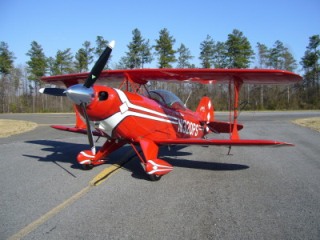- Basic
Known Compulsory.
This is a set of figures published prior to the contest season. Every pilot flies the same set of figures. - Sportsman
Known Compulsory and Free Program.
Sportsman pilots fly the Known compulsory twice and are also permitted to compose a Free Program of his/her own design, subject to certain restrictions. - Intermediate
Known Compulsory, Unknown and Free Programs.
Intermediate pilots not only fly a more complex Known compulsory, they also must fly an Unknown compulsory that is distributed by IAC Headquarters to the competitors only a few hours before the flight and that cannot be practiced. The Unknown is a test of the pilot's ability to fly a group of figures in a certain sequence that he/she has not flown before. Intermediate pilots also compose a Free Program of his/her own design, subject to certain restrictions. - Advanced
Known Compulsory, Unknown and Free Programs.
Advanced pilots fly even more complex Known, Unknown and Free programs. The top ranked pilots qualify to be on the U.S. Advanced Aerobatic Team which competes in world-level aerobatic competitions. - Unlimited
Known Compulsory, Unknown, Free and 4-Minute Freestyle Programs.
The Unlimited pilot flies the most complex and difficult sets of figures of all competition pilots. He/she also must fly an extremely high-performance aircraft capable of flying the figures which are required. The 4-Minute Freestyle program is often very exciting and entertaining for the audience and demonstrates both the technical difficulty level the pilot has attained, plus artistic performance. The top ranked Unlimited pilots qualify to be on the U.S. Unlimited Aerobatic Team which competes in world-level aerobatic competitions.
Competition Aerobatics
|
In aerobatic competitions, every competitor flies a series of flights that are graded by a team of judges. The judges grade each individual figure flown, as well as how well the sequence is positioned within the aerobatic box. The figures are graded on such factors as: � precision of the lines and angles, � symmetry of figures, and � other factors as spelled out in the IAC "Official Contest Rules." |
|
Each judge has a copy of the figures the pilot will fly. On these sheets the figures are graphically represented by symbols - a system devised by Jose L. Aresti of Spain. In addition to the graphical symbol, each figure is assigned a difficulty coefficient or "K factor" based on the difficulty involved in performing the figure. The judges, in turn, grade the figure on a scale of 0 to 10. The K factor and grade are multiplied to derive the points for that figure. A computer scoring program then adjusts the totals to account for bias or inconsistency.
Regional Contests
The International Aerobatic Club sanctions approximately 50 regional
aerobatic contests annually that are hosted by various IAC
Chapters. A complete
Calendar
of Events is published monthly.
Championship Events
The IAC also hosts two Championship
events
annually - one National and one International competition. The U.S.
National Aerobatic Championships are held each year in September in
Denison, TX. The U.S. National Aerobatic Champion is crowned at this
competition. At the IAC Championships/Championships of the Americas, a
roving competition, the IAC champion is chosen.
The Competitors
There are five competition categories for powered aircraft - Basic,
Sportsman, Intermediate, Advanced and Unlimited, and three categories
for glider aircraft - Sportsman, Intermediate, and Unlimited. Each
competition category flies a different set of sequences with varying
degrees of difficulty.
What are the Requirements to Compete
in a Sanctioned Aerobatic Contest?
You must be a member of the Experimental Aircraft Association (EAA)
and the International Aerobatic Club (IAC), a division of the
EAA.
You must also possess at least a Private Pilot Certificate, ASEL, and
have a current medical to compete in a contest.
The Buddy System
All first time competitors have an experienced aerobatic pilot
assigned to you for guidance and advice during a contest.
The Judges
The flying is judged by IAC approved judges. There are specific
judging criteria for each figure. All allowed figures are specified in
the IAC Contest Rule Book. Each figure is assigned a difficulty
factor. The final score is then calculated from the score that the
judges give for each figure (in the range of 0 - 10), multiplied by
the difficulty factor. The total score for a sequence is the sum of
the scores for each figure.
To become qualified to judge an aerobatic contest, an individual must attend an approved IAC Judges School held at varying locations throughout the year, complete an IAC Judges Home Study course, and be an assistant to a grading judge in no less than 40 flights within an 18-month time period. To remain current a judge must pass a Recertification and Currency exam annually and have judged at least 30 flights during the previous year.
The Contest Volunteers
There are plenty of opportunities for non-competitors and non-pilots
to be involved at aerobatic contests. In fact, the volunteer is the
heart of IAC competitions. It takes several volunteers to run a
contest. In addition to a Contest Director, there is an Assistant
Director, a Contest Jury, a Chief Judge, an Assistant Chief Judge,
Judges, Assistant Judges, Recorders, Boundary Judges, Deadline Judges,
a Safety Director, Medical Director, Volunteer Coordinator, Technical
Director, Registrar, Scorers, Starters, Runners, Box Panel Flippers,
Social Coordinators, and Merchandise Coordinators.

